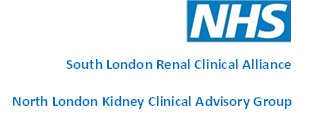
Review of London kidney teams’ response to COVID-19, March-June 2020
Summary of key themes
Patient support, advice and information – ‘let’s turn our faces to the front door‘
- Meeting and greeting patients is simple but effective
- How can we ‘walk with’ patients better through their journey: explore options for named nurses or case managers
- Choice (and information to support it) is ever more important – for example, the communication of risk associated with in-centre haemodialysis, and provision of pathways to facilitate home therapies or supportive care where chosen.
- Advanced care planning and frailty assessments are essential and should be part of routine care and conversations with patients
- There is an opportunity to improve patient information across London so that it is consistent, accessible and embraces technology, ideally through one repository
- Wellbeing support for both patients and staff is vital
Infection control
- A variety of approaches to segregation and isolation were implemented across London but there was no clear signal that one isolation strategy was more effective
- Expansion and availability of home therapies as a treatment option can help to minimise risk
- Provision of a transport hub with regular sharing of information about capacity, dynamic learning, and guidance reduced enabled units to balance the risk of missed dialysis sessions against the need to optimise infection control
Workforce
- Collaboration and sharing of workforce within services and across services with rapid onsite training and refresher courses was vital
Next steps
- Use the London Networks to review workforce and consider a contingency approach to maintain renal services during a second surge
- Use the London Networks to convene a London patient information group with appropriate stakeholders
- Explore the meet and greet concept used during COVID-19, considering named clinicians, care navigators or case managers
Summary of discussions
What worked well?
- A variety of approaches to segregation and isolation were implemented across London; there was no clear signal that one isolation strategy was more effective than others
- Clinical leadership and collaboration across the whole of London with mutual support
- Collaboration and sharing of workforce within services and across services with rapid onsite training and refresher courses—medical students, dentists, surgeons, dieticians, pharmacists provided full support to dialysis patients
- Meet and Greet triage of all patients provided a welcome and reassurance from staff
- Patient HELPLINE provided in various forms by telephone or email provided access to information regarding treatment options during COVID-19 allowing signposting and triage of a spectrum of patient issues raised during COVID-19 as a result of changes in ordinary processes
- Kidney Care UK website provided timely high quality accessible patient information
- Transport Hub—to share regular capacity information and create pan-London guidance
- Active engagement and support of all staff, either sick or shielding, by senior leadership teams either by face-to-face visits or regular phone calls
- Promotion or expansion of home therapies programmes as a treatment option to minimise risk
- Written communication to all patients to maintain updates on the latest guidance.
- Trust websites hosting key information with useful links for patients
- Scripted information for teams to communicate to patients for consistency and clarity
- Renal dietitians were placed in some satellite units to support with diet/fluid management for patients on reduced hours/twice weekly dialysis
Ideal patient information: Keep It Short and Simple (KISS). Explain all technical language and make sure it’s read and sense checked by a wide range of patients.
Key challenges
- Protecting patients on ICHD ensuring all 12 themes are met in such a short time frame
- Protect patients by protecting staff – maintain a resilient workforce
- Maintaining consistent and updated communication with patients and families
- Strategies to maintain communication with families and loved ones of patients unable to communicate during an inpatient stay
- Providing clear and accessible patient information in the face of constantly changing NHSE/government communications to the whole population rather than considering specific groups of people with particular risk factors
- How to embed advanced care planning in care pathways at the right time to reflect the long-term teams knowledge of the patient and families wishes
- How do we maintain HD skills in qualified HD staff who move to work in other renal specialist clinical areas such as transplant or dialysis preparation and ITU to redeploy quickly during a second surge
- Maintain a workforce in all treatment areas such as transplantation, low clearance, home therapies and vascular access
- Ensuring equity and equality of access to all patients to treatment options and decision making
- Consistent transport guidance was lacking during the surge
What could we do better?
- Maintain renal nursing expertise in HD and PD
- Maintain and assure equity of access to other services such as low clearance, supportive care, transplant and vascular access
- Communication with patients and carers, especially if an inpatient; consider examples of good practice like a daily telephone update
- Provide more comprehensive wellbeing support for patients and staff
- Providing better peer support – access to other patients’ experiences and sharing of information – active peer supporting in the young adult patient community throughout this time has helped both with practical but also psychological challenges that people have faced
- Easily accessible information using technology to enable equity of access for the hard of hearing, partially sighted, other disabilities and for those who are hard to reach.
- Escalation plans on, or prior to, admission— using validated frailty tools and Advanced Care Planning to facilitate conversations and prepare patients and families for these decisions
- Improve patient information: Keep It Short and Simple (KISS). Explain all technical language and make sure it’s read and sense checked by a wide range of patients
